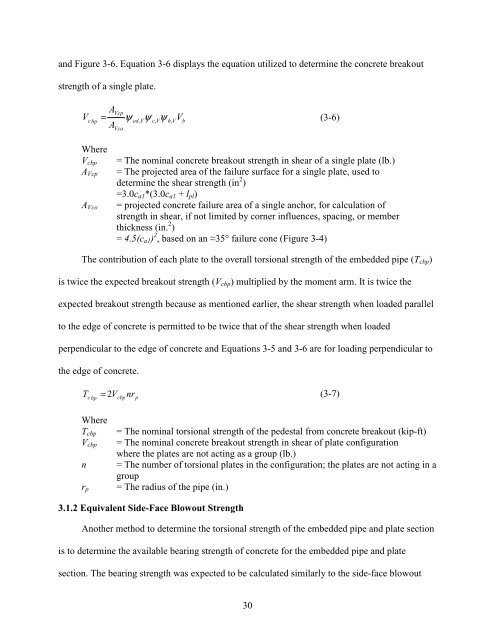Alternative Support Systems for Cantilever - National Transportation ...
Alternative Support Systems for Cantilever - National Transportation ...
Alternative Support Systems for Cantilever - National Transportation ...
You also want an ePaper? Increase the reach of your titles
YUMPU automatically turns print PDFs into web optimized ePapers that Google loves.
and Figure 3-6. Equation 3-6 displays the equation utilized to determine the concrete breakout<br />
strength of a single plate.<br />
A<br />
= V<br />
(3-6)<br />
Vcp<br />
V c ψ<br />
bp<br />
ed,<br />
Vψ<br />
c,<br />
Vψ<br />
h,<br />
V<br />
AVco<br />
b<br />
Where<br />
Vcbp = The nominal concrete breakout strength in shear of a single plate (lb.)<br />
AVcp = The projected area of the failure surface <strong>for</strong> a single plate, used to<br />
determine the shear strength (in 2 )<br />
=3.0ca1*(3.0ca1 + lpl)<br />
AVco = projected concrete failure area of a single anchor, <strong>for</strong> calculation of<br />
strength in shear, if not limited by corner influences, spacing, or member<br />
thickness (in. 2 )<br />
= 4.5(ca1) 2 , based on an ≈35° failure cone (Figure 3-4)<br />
The contribution of each plate to the overall torsional strength of the embedded pipe (Tcbp)<br />
is twice the expected breakout strength (Vcbp) multiplied by the moment arm. It is twice the<br />
expected breakout strength because as mentioned earlier, the shear strength when loaded parallel<br />
to the edge of concrete is permitted to be twice that of the shear strength when loaded<br />
perpendicular to the edge of concrete and Equations 3-5 and 3-6 are <strong>for</strong> loading perpendicular to<br />
the edge of concrete.<br />
T = 2V<br />
nr<br />
(3-7)<br />
c bp<br />
cbp<br />
p<br />
Where<br />
Tcbp = The nominal torsional strength of the pedestal from concrete breakout (kip-ft)<br />
Vcbp = The nominal concrete breakout strength in shear of plate configuration<br />
where the plates are not acting as a group (lb.)<br />
n = The number of torsional plates in the configuration; the plates are not acting in a<br />
group<br />
= The radius of the pipe (in.)<br />
rp<br />
3.1.2 Equivalent Side-Face Blowout Strength<br />
Another method to determine the torsional strength of the embedded pipe and plate section<br />
is to determine the available bearing strength of concrete <strong>for</strong> the embedded pipe and plate<br />
section. The bearing strength was expected to be calculated similarly to the side-face blowout<br />
30
















